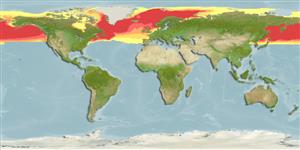Preferred temperature (Ref.
123201): 0.3 - 7.1, mean 2.7 °C (based on 956 cells).
Índice de diversidade filogenética (Ref.
82804): PD
50 = 1.0000 [Uniqueness, from 0.5 = low to 2.0 = high].
Bayesian length-weight: a=0.00363 (0.00291 - 0.00454), b=3.21 (3.14 - 3.28), in cm total length, based on LWR estimates for this species (Ref.
93245).
Nível Trófico (Ref.
69278): 3.2 ±0.1 se; based on diet studies.
Resiliência (Ref.
120179): médio(a), tempo mínimo de duplicação da população 1,4 - 4,4 anos (K=0.3-0.5; tm=3; tmax=10; Fec=6,000).
Prior r = 0.62, 95% CL = 0.41 - 0.94, Based on 5 full stock assessments.
Fishing Vulnerability (Ref.
59153): Low to moderate vulnerability (27 of 100).
🛈
Climate Vulnerability (Ref.
125649): Low vulnerability (24 of 100).
🛈
Nutrients (Ref.
124155): Calcium = 61.5 [23.6, 173.6] mg/100g; Iron = 0.789 [0.272, 2.351] mg/100g; Protein = 16.4 [15.2, 17.5] %; Omega3 = 0.546 [0.230, 1.330] g/100g; Selenium = 13.4 [4.3, 35.4] μg/100g; VitaminA = 21.6 [4.0, 119.8] μg/100g; Zinc = 0.682 [0.407, 1.150] mg/100g (wet weight); based on
nutrient studies. 